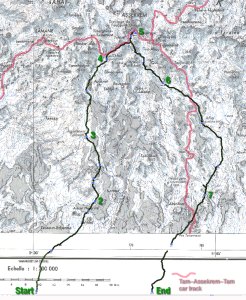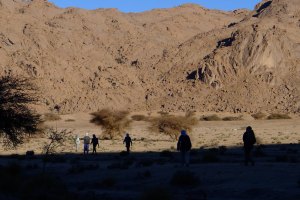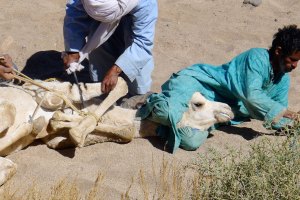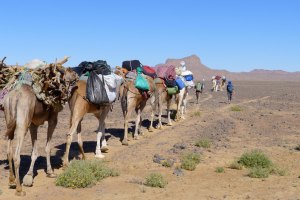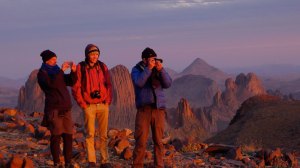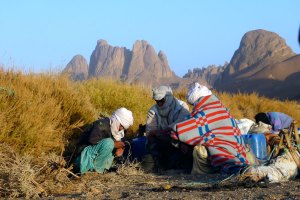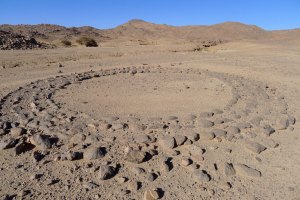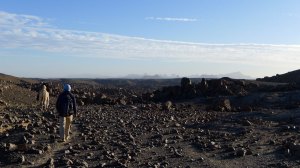See also the Sahara Trekking eBook
It was a full, two-day drive from Bit Outene at the end of our 12-day Immidir trek to the base camp east of Tam airport for our walk up to Assekrem (map right) and down again.
On the way we overnighted at Erg Mehajibat (left) and stopped off for some wafers and fizz at Arak where we said goodbye to Mohamed our Immidir guide. As always, these are curt, brief affairs, but he knew we’d all had a great time with him and his crew who were now trekking back from Bit Outene with the caravan, about a week’s journey.
Just before Tam airport we were met by Ben Kada’s boss, another Mohamed, who had more juice and biscuits for us – a nice touch. He invited me into his pickup and within an hour we were dropped in a oued to meet the new Kel Ahaggar camel crew and set off scratching around for firewood which would be lean in the Hoggar. As expected, it was a freezing night at 1550m (left) and we set off next morning along a oued leading north towards a piton of rock alongside a massif, one of the many column-clad volcanic plugs which give this central core of the Hoggar – the Atakor – its distinctive look. After an early lunch (left) we continued our climb onto the evocatively named Plateau of the Sky Wind, composed of basalt rubble the size of baby’s heads. As with many mountain treks, we gained our altitude in sudden steps rather than a gradual ascent. The Sky Wind in turn led to our camp for the night (left), a nest of tan, granite boulders overlooking the cone of Adrar Hedjrine. Compared to basalt, granite is a much friendlier rock to spend time on. Once our pitches were set and with little firewood, we hunkered down under blankets, solved problem of Middle Eastern politics once and for all, and waited for another great dinner.
We stayed on the granite next morning as Honi our guide led us up, over and down into a basin called The Palm (left), from which we scrambled back out to rest under a smooth-lipped cave adorned with pre-historic cattle images. I can’t say I recall seeing rock art painted on coarse granite before, but supposing it was at least 5000 years old, it had lasted well. I always understood that ochre and other pigments survived so well on sandstone because of a chemical bond with the rock surface – could it be the same on less fine and less porous granite?
We continued our scramble and emerged on another ankle-testing basalt plateau at 2000m (left). Below us the caravan passed along an easier route and led us to a palmy spring of Tin Amelout in the Oued Amsa for lunch.
As we washed and waited to be fed, a group of camels including a mother and her calf wandered by. The young animal was duly snared, knocked down and trussed up with much commotion, and then branded with a bar. Initially I thought this was an opportunistic grab of an unbranded ‘cleanskin’, but it turned out the mother shared the brand of our caravan’s camels, so the crew were just marking what was theirs.
Back in the Immidir I’d mentioned to the group that our Ahaggar crew might be more tourist savvy or weary than the Ahnet bunch, because in the good years this route would have been frequently taken by tourists. Honi, his young son, brother and brother in law were old timers with the agency (unlike the Arak crew), but for some reason they remained a reserved and occasionally unfriendly bunch, as in sneering: ‘Are you looking for something?’ as I helped unpack a heavily-loaded camel at the end of a day. Even Tayub who was from around here, knew the crew and had done this route 40 times, was more reserved. The cause of all this perplexed us but was either low pay or just tourist fatigue and boredom. It certainly wasn’t us who, after a fortnight in the desert, were an undemanding and acclimatised group. As on previous occasions, it was clear that they got the gist when we talked about this [in English] and occasionally made an effort, but really their heart wasn’t in it, unlike the Ben Kada agency itself or the guys from Arak.
The odd staging, with early or very long lunches also took some getting used to. We concluded that we were following an easy, ‘starter’ circuit aimed at recently flown-in tourists, and not hardened desert vets like us. The glum crew, dearth of firewood, occasional rubbish and car tracks, plus the sometimes bleak surroundings took the edge off the walk, but as a well-bonded throng, we took it all without complaint because it sure was better to be walking out here in the Hoggar than most other things.
After lunch the guides hooked the mother and newly branded calf onto the caravan and tried to shoo away the other roaming camels who’d lost part of their troupe. Even that evening at our camp by a chilly guelta of Talmest, the herd stalked us from the ridge top, like Apache’s about to attack. At one point the young calf escaped its tether and made a dash for the ridge, but was chased and retrieved by Honi’s 18 year-old-son. As in the Immidir, the ways of camel trekking were being passed down to the next generation. With tourism crippled year by year, whether they’d get as much of a chance to put it into practise, like their aged fathers, was another matter.
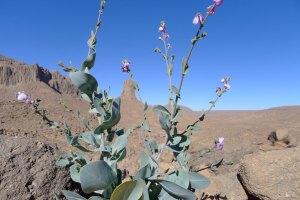

Cooler, less arid and twice the elevation of the Immidir, there were a lot more flowers (left) up here in the Hoggar, even though we were told it had not rained since the summer. I don’t know what any of them were but we were told it was the reason the hobbled camels set off up the rubble clad hillsides for a nibble every chance they got. At one point, after burning some plastic rubbish he came across, Honi stopped at a bulge of sand and carefully dug up a dense mushroom which I realise now was a truffle (left). Within a few minutes he had a few more and pointed to where rabbits had been digging others up. Just as he said that, a big rabbit or hare broke its cover and dashed off. I’ve never seen one before out here. Grilled on coals, the mushies made a delicious snack in the lunch oued an hour or two later.
That night’s camp at around 2200 metres was a grubby oued just short of the Assekrem track. This time we scoured the vicinity for scrub to burn, and using the oued bank wall, managed to keep ourselves warm under blankets (left) until Tayub brought over the dinner. Once the tea was served, we all made a dash for our sleeping bags.
Jackals howled overnight but by lunchtime next day we were at a cleared patch of ground by a small ruin, just below the col of Assekrem. Clearly it wasn’t going to be too balmy here tonight so we figured we’d earned a night indoors up at the auberge on the pass – all the better positioned to strike out for sunset and sunrise duties, too.
Up on top (left and below) a rowdy bunch of Turkish tourists were also enjoying the spectacle. Some of the world’s well known touristic wonders can lose their magic or be over-rated, but for me, like Ayers Rock or Monument Valley, Assekrem is no less amazing, even if you’ve been here half a dozen times. As expected, the ordinary meal we got back down in the lodge underlined what a great job Tayub our cook was doing in feeding us off the back of a camel for weeks at a time.
We all bundled into one room while the Turks sang and hollered till the early hours – and then before 6am the dedicated hauled themselves up again to stake their claims on the dawn. I took off up the rock opposite the hermitage (the lump on the right of the picture, left) where most go, sat myself in an enclosure against the wind and fired the camera into the primeval scene emerging from the night. I can’t say this vantage point is any better then the usual one, except that you’ll probably be alone.
After brekkie in the lodge, we traipsed back down to the caravan camp as arranged, but they were having a slow morning and the camels were still all over the mountainside (right), looking for those flowers. Once they were eventually brought in and loaded, we backtracked from Assekrem and set off for the three day descent, along a steep valley peppered with more flowers. Narrow clefts led over thick pools of ice, and out onto a plain we passed a nomad camp. As the day ended we set down in another oued with the Atakor’s spires behind us (left) for another freezing night mitigated by a bush scrub fire. A changeable wind rose after sunset and by 4am it was howling a gale. The empty tent I was using as a windbreak flapped remorselessly, making a racket; in future I’d be better off just huddling down under a quiet blanket like the nomads.
The secret of a good group is that they remain cheerful even after a grim night where few had slept well. Some had crawled in to share tents, and others had their tents snap over them, making an even worse din. Breakfast was delivered with stuff flying past and we then set off down the valley. Soon we joined the main, eastern arm of the car track to Assekrem which we followed briefly and then turned off at the twin ‘Mac D’s’ arches for the guelta at Afilal.
I’d never stopped here before. I think I tried to once but was shooed away by the army. Even then, I assumed it would be a grubby, rubbish-strewn dump, especially if army were camped nearby. In fact the Ahaggar national park guardian based there in an old portacabin was thrilled to see tourists and grabbed a photo with us for his next newsletter while behind us volunteers (or possibly miscreants) lethargically collected rubbish scattered around the main guelta. In fact there’s a lot more to Afilal than that waterhole and with Tayub and the lunch camel alongside, we followed the source downstream past trickling waterfalls, deep green pools and smooth, flood-washed granite until we found a wind free corner for another great salad lunch. I’ve never seen so much running water in the Sahara.
That afternoon was one of the best of the walk, not least because we put in a good 15 clicks after lunch. We followed the Afilal valley until it petered out and then crawled over low ridges into adjacent valleys and basins separated by more hills. Away from the grim basalt plateaux, we explored the granite ranges, passing a cobbled stone circle (left) just like the one we saw in Tadant oued, some 200km east of here at the tail end of SEQ in 2006. What they are exactly is still a mystery. A tomb is the most obvious answer, as these are the structures which most commonly survive, but most tombs have a focal point like a mound; this was just a very finely set flat ring of stones. It may just have been a pilot’s marker like this, but they are usually much bigger and out on the plain. Nearby, less well made examples had broken up over the years and in a nearby guelta, a flood-carved basalt pavement (below) added a natural wonder to the scene.

The caravan had taken a more direct route, but Honi was unsure where they had made camp. He crissed crossed the terrain, looking for tracks just we were beginning to creak a bit after hours of walking. Eventually we backtracked (see the map track) and staggered into another perfect camp in a oued set among beige granite boulders. Here we managed to scrape together enough acacia to encircle a fire ahead of our last day of trekking. That night it was probably minus 5.
Another great morning led us through the boulders to Akar Akar mountain to cross over the car track and get back inside the Hoggar ‘loop’. Steve had chosen to ride a camel that morning, little did he know he would be sat on the acacia plank till lunchtime, but when we caught him up he was fine. To the south lines of cones marched across the horizon in the blue haze and by mid-afternoon one more basalt rubble ascent and descent brought us above the last oued camp near the distinctive cone of Adaouda where Patrick found a fine Tuareg dagger while looking for fire wood.
I’d long wanted to try this walk and the Hoggar trek had passed through some amazing country side. But we couldn’t help compare it with the wild Immidir we’d just visited where the most conspicuous signs of man were usually 6000-year-old tombs. Tayub kept us as well fed as before, but the grumpy crew too took the edge off the experience and the sun rising or dropping over Assekrem is no less amazing for having driven up there so I’m not sure I’d do this trek again.
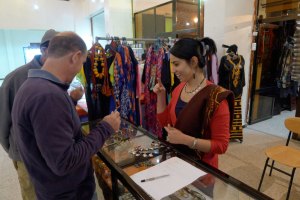
So, after 200 miles walking and nearly three weeks of bush camping, all that remained was a long overdue hose down at Loukmane’s house in Tam, followed by a haircut, some interneting, shopping (left) and a non-goat based feed at a resto in town. The night plane flew us back to Algiers via Djanet which gave us an extended chance to doze. A few hours later we were all on our way home while I conjured up plans for next time.



